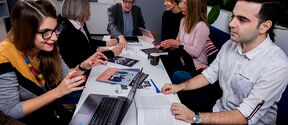Promising news from biomedicine: DNA origami more resilient than previously understood
DNA origami nanostructures (green triangles) survive although magnesium concentration is drastically decreased from fabrication conditions. Image: Boxuan Shen and Veikko Linko
The DNA origami technique is a widely used method for making complex, yet well-defined nanostructures, with applications in biophysics, molecular biology, as well as drug and enzyme delivery. A major challenge, however, has been in achieving long-lasting stability under the conditions required for these applications.
Until now, the technique has required high concentrations of magnesium well above those found in the human body.
"Conventional DNA origami assembly requires levels of magnesium easily 10-30 times as high as those in normal physiological conditions. With our method, we can go below one thousandth of the minimum magnesium concentration previously reported," says Adjunct Professor Veikko Linko from Aalto University, who co-led the study with Dr. Adrian Keller of Paderborn University.
Key to the gentle buffer exchange method developed by the researchers is removing free ions from the buffer solution efficiently but not all residual magnesium from the nanostructures. Previous research has identified low magnesium levels as one of the most critical parameters that reduce DNA origami stability in cell culture media.
"We found – quite surprisingly – that just Tris and pure water worked well with low-magnesium levels for all types of structures," explains Linko.
Tris is a common component of buffer solutions used, for example, in biochemistry applications. Findings show that phosphate-based buffers with a high enough concentration of sodium or potassium can also stabilize DNA origami.
The study investigated the stability of quasi-one-dimensional, two-dimensional and three-dimensional DNA origami objects. The nanostructures achieved using the technique showed strong structural integrity, maintained even for extended periods of time.
"We can store the structures in low-magnesium conditions for weeks and even months without seeing any structural defects. These findings might pave the way for a plethora of biomedical uses that were previously thought impossible, as for example fluorophores and many enzymes are sensitive to magnesium levels," envisions Linko.
The researchers further observed that the more tightly packed the helices in their DNA objects were, the more sensitive they were to the environment in low-magnesium conditions. This suggests that the stability of DNA origami can be enhanced through the optimization of the design procedure.
The results have been published in Angewandte Chemie International Edition and the article has been selected as a “Hot Paper”.
“On the Stability of DNA Origami Nanostructures in Low-Magnesium Buffers”
Angewandte Chemie International Edition 2018
DOI: 10.1002/acie.201802890
http://dx.doi.org/10.1002/anie.201802890
The research has been funded by Academy of Finland, Jane and Aatos Erkko Foundation, the Sigrid Jusélius Foundation and Deutsche Forschungsgemeinschaft.
More information:
Adjunct Professor Veikko Linko
Biohybrid Materials Group, Aalto University School of Chemical Engineering, Finland
tel. +358 45 673 9997
veikko.linko@aalto.fi
Read more news

Research Council of Finland establishes a Center of Excellence in Quantum Materials
The Centre, called QMAT, creates new materials to power the quantum technology of coming decades.
Major funding powers development of next-generation machine technology aimed at productivity leap in export sectors
The BEST research project is developing new types of sealing, bearing, and damping technology.
The TAIMI project builds an equal working life – a six-year consortium project seeks solutions to recruitment and skill challenges
Artificial intelligence (AI) is changing skill requirements, the population is aging, and the labor shortage is deepening. Meanwhile, the potential of international experts often remains unused in Finland. These challenges in working life are addressed by the six-year TAIMI project funded by the Strategic Research Council, and implemented by a broad consortium.






